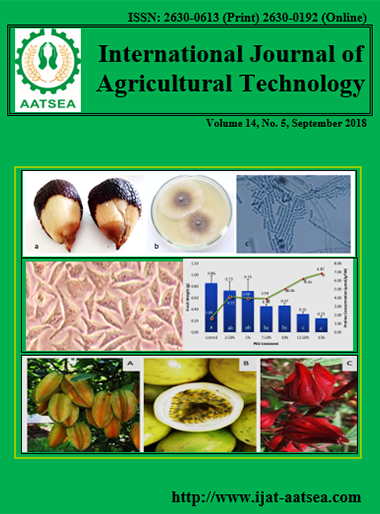Fluorescent Inter Simple Sequence Repeat (F-ISSR) Markers and Capillary Electrophoresis to Assess Genetic Diversity and Relatedness within Commercial Sugarcane Varieties
Main Article Content
Abstract
The proper selection of genetically rich diverse parents is a very useful strategy for the success of sugarcane breeding program. One of the crucial factors in sugarcane breeding and sugar production is the selection of the suitable variety because different varieties have different yield potentials, pest and disease resistance property and is bred for different ecological and economic conditions. The level and patterns of molecular genetic diversity and establishing relationships among 19 varieties of sugarcane using fluorescent Inter Simple Sequence Repeat (F-ISSR) markers and capillary electrophoresis was evaluated. Out of nine primers, 3 primers were found to give clear and polymorphic patterns. F-ISSR primers were labeled with 6-carboxyfluorescein and consists of di-nucleotide motifs. Total countable bands were 1142 among which 1099 comprised of polymorphic markers, with an average of 366 polymorphic bands per primers. Dendrogram showed that there are 5 clear clusters. The size range of the amplification products varied from 50.14 to 500bp. A total number of 246 alleles were detected per primer and the average number of allele per locus was 12.95.Only two monomorphic bands were detected with two primers at a particular locus. 41 unique bands were identified. The study showed that the F-ISSR markers detected high level of polymorphism (96.42 %) or genetic diversity among nineteen varieties of sugarcane. The present information recoded in this study would definitely give a useful guideline in planning hybridization for the maintenance and improvement of genetic diversity in sugarcane varieties.
Article Details

This work is licensed under a Creative Commons Attribution-NonCommercial-NoDerivatives 4.0 International License.
References
Ansorge, W., Sproat, B., Stegemann, J., Schwager, C. and Zenke, M. (1987). Automated DNA sequencing: ultrasensitive detection of fluorescent bands during electrophoresis. Nucleic Acids Research 15:4593-4602.
Avise, J. C. (1994). Molecular Markers, Natural History, and Evolution. Chapman & Hall, New York. 511 p.
Da Costa, M. L. M., Amorim, B. L. L., Onofre, C. V. A., de Melo, T. O. J. L., de Oliveira, M. B. M., de Carvalho, R. and Benko-Iseppon, M. A. (2011). Assessment of genetic diversity in contrasting sugarcane varieties using Inter-Simple Sequence Repeat (ISSR) markers. American Journal of Plant Sciences 2:425-432.
Dunham, R. A. (2002). Aquaculture and Fisheries Biotechnology, Genetic Approach. CABI Publishing, Cambridge, USA. pp.85-99.
Godwin, I. D., Aitken, E. A. B. and Smith, L. W. (1997). Application of inter simple sequence repeat (ISSR) markers to plant genetics. Electrophoresis 18:1524–1528.
Gupta, M., Chyi, Y-S., Romero-Severson, J. and Owen, J. L. (1994). Amplification of DNA markers from evolutionarily diverse genomes using single primers of simple-sequence repeats. Theoretical and Applied Genetics 89:998-1006.
Gupta, P. K. and Varshney, R. K. (2000). The development and use of microsatellite markers for genetic analysis and plant breeding with emphasis on bread wheat. Euphytica 113:163-185.
Kassahun, T., Govers, K., Endashaw, B. and Borsch, T. (2014). ISSR fingerprinting of Coffea arabica throughout Ethiopia reveals high variability in wild populations and distinguishes them from landraces. Plant Systematics and Evolution 300:881-897.
Kawar, P. G., Devarumath, R. M. and Nerkar, Y. (2009). Use of RAPD marker for assessment of genetic diversity in sugarcane cultivars. Indian Journal of Biotechnology 8:67-71.
Meyer, W., Mitchell, T. G., Freedman, E. Z. and Vilgalys, R. (1993). Hybridization probes for conventional DNA fingerprinting used as single primers in the polymerase chain reaction to distinguish strains of Cryptococcus neoformans. Journal of Clinical Microbiology 31:2274-2280.
Obručová, H., Tihelková, R., Kotásková, I., Růžička, F., Holá, V., Němcová, E. and Freiberger, T. (2016). Evaluation of Fluorescent Capillary Electrophoresis for Rapid Identification of Candida Fungal Infections. Journal of Clinical Microbiology 54:1295-1303.
Reddy, M. P., Sarla, N. and Siddiq, E. A. (2002). Inter simple sequence repeat (ISSR) polymorphism and its application in plant breeding. Euphytica 128:9-17.
Saker, M. M., Bekheet, S. A., Taha, H. S., Fahmy, A. S. and Moursy, H. A. (2000). Detection of somaclonal variations in tissue culture-derived date palm plants using isoenzyme analysis and RAPD fingerprints. Biologia Plantarum 43:347-351.
Schlötterer, C. and Tautz, D. (1992). Slippage Synthesis of Simple Sequence DNA. Nucleic Acids Research 20:211-215.
Srivastava, S. and Gupta, P. S. (2008). Inter Simple Sequence repeat profile as a genetic marker system in sugarcane. Sugar Tech 10:48-52.
Srivastava, A. K. and Rai, M. K. (2012). Sugarcane production: Impact of climate change and its mitigation. Biodiversitas 13:214-227.
Staub, J. E., Serquen, F. C. and Gupta, M. (1996). Genetic markers, map construction, and their application in plant breeding. HortScience 31:729-739.
Weising, K., Nybom, H., Wolf, K. and Kahl, G. (2005). DNA fingerprinting in plants: Principles, Methods and Applications (2nd ed). CRC Press, Boca Raton, Florida, USA.
Wu, K., Jones, R., Dannaeberger, L. and Scolnik, P. A. (1994). Detection of microsatellite polymorphisms without cloning. Nucleic Acids Research 22:3257-3258.
Zietkiewicz, E., Rafalski, A. and Labuda, D. (1994). Genome fingerprinting by simple sequence repeat (SSR) -anchored polymerase chain reaction amplification. Genomics 20:176-183.


